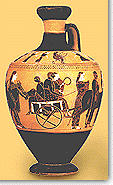









         | |
|
|
Between |
The name Amasis Painter was taken from the potter whose vases he quite often decorated. However, most probably the painter and the potter were one and the same person. As his career lasted for over thitry years, he created and decorated almost every type of vase -except hydries and craters- and his technique was greately developed. His favourite shapes were the neck amphora and lekythos of the "Deianeira" type. However, besides being a very good painter he also was an excellent engraver. He decorated with detailed accuracy patterns and draperies, weapons, especially the emblems of shields. He preferred Dionysian thematology and his expertise in part heralded the red-figure technique, which was to follow. |  |
Exekias was also a potter and painter and owed a lot to the technique and the tradition of the group from which he came, and which is conventionally called "group Ε". He is distinguished for the statuesque standards of his figures, the developed three-dimensional folds of the clothes, the rich patterns, the well-made shields and the trimmed manes of the horses. His innovations extended in every sector: probably it was he who for the first time used the coral-red colour and drew the known apotropaic eye, the so-called "eye" kylikes. Furthermore, he chose most original ways for the depiction of known mythological episodes, as in the case of Ajax's suicide or the return of the Dioskouroi. |
During the same period miniature painting is also developed, which was better suited to the various types of kylikes that were produced in the Athenian Ceramicus. According their decoration and shape they are classed as Gordion kylikes, lip kylikes, band kylikes, Droop and Cassel kylikes. Many new shapes were introduced by the potter Nikosthenes, apparently influenced by the types of the Etruscan bucchero. The amphora, kyathos and pyxis are some of its most characteristic shapes, and thus they are called "Nikosthenic". This period -which is the apex of the black-figure style- finishes with the first signs of exhausting its possibilities, which already appear in the manneristic work of the Affecter and of the Elbows out Painter.
|
| |
|
Note: Click on picture for short description. | |